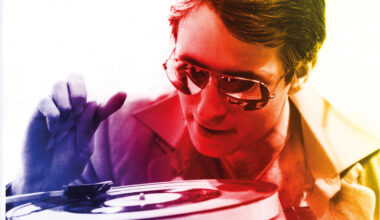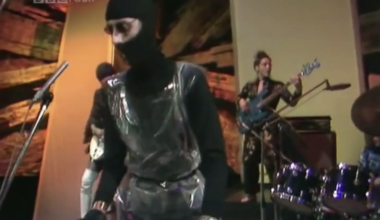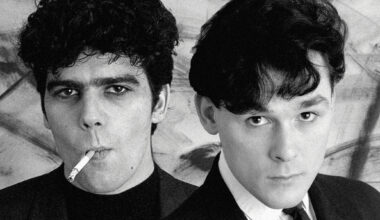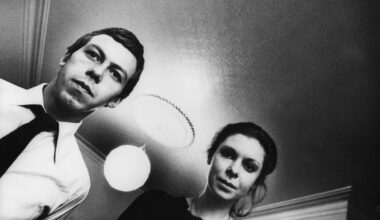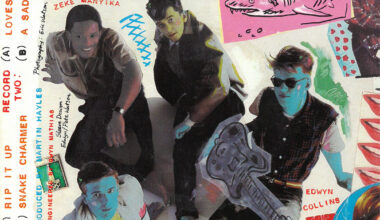Fred Deakin remembers the making of the infectious and influential Lemon Jelly cut ‘The Staunton Lick’, from 1999’s ‘The Yellow EP’

“Nick Franglen and I both grew up in north London, around Kentish Town. We didn’t really know each other, but we had mutual friends and he once took my sister out. As teenagers we’d both been in a few bands, and we were also big fans of 23 Skidoo who were local heroes. I’d bump into Nick at their gigs. As well as playing in bands, I’d also started DJing – bottom of the bill at this stage – at places like Diorama in Kings Cross, Sol Y Sombra in Soho, and the hip hop club, Titanic.
“In 1984 I moved to Edinburgh to study, and while I was there the DJing progressed into promoting my own club nights. I still think of myself primarily as a DJ. After a couple of years I organised these events called Thunderball. We used unusual venues like art galleries, casinos and ice rinks, and the music was a total mix. Eclectic is an overused word these days, but I was playing soul and funk along with more curveball tracks like heavy metal and country & western. Trying to break down barriers.
“In 1994, I applied to study graphic design at St Martin’s and moved back to London. My interview portfolio was a bunch of club flyers that I’d designed and a fanzine. I didn’t even have an art O-Level, but they gave me a shot. I’d been messing about with music and samples. I’m a big hip hop fan, and was in awe of people like A Tribe Called Quest. I was thinking that if I got a record out, it might give my DJ career a bit more oomph, but I wasn’t really getting anywhere. Then a friend suggested I give Nick a buzz.
“While I’d been away, Nick had moved into music production. He had his own studio and had worked with people like Pulp, Primal Scream, Blur and Hole. I studied cello at school, but Nick really understands music – he can pick up any instrument and play it almost immediately. Lemon Jelly was the classic DJ-and-producer duo, at least initially. I’d basically come in with a sack of samples and together we developed ideas and tracks.
“I’d worked with typography legend Ian Swift – aka Swifty – for two-and-a-half years, and was very excited about designing our sleeves. They were so elaborate that there was no way it was going to be a money-making exercise. We just wanted to put something out there that was as perfect as we could make it with the resources we had – something we could be totally proud of. I do think that the artwork helped us to stand out, and it intrigued people at magazines enough for them to give the promos a listen. This strong visual identity was one of the things that made Lemon Jelly unique.
“We were incredibly lucky with our early records. We had a great PR company called Zzonked, and my sister also happened to be working with John Peel, who was the first person anywhere to play our debut EP. Apparently, Gilles Peterson was in the next studio and rushed in to find out what it was.
“The sound sources we were using came from car boot sales and charity shops. Not so much library music, more random 50p purchases – we sampled Nana Mouskouri on our first album. I’d run easy listening nights in Edinburgh, and in London I knew DJs like the Karminskys and Martin Green from the clubs Blow Up and The Sound Gallery. That vibe definitely permeated the Lemon Jelly stuff.
“‘The Staunton Lick’ evolved from two samples taken from John Pearse’s record, ‘Teach Yourself Folk Guitar’. The copy that I have used to be my dad’s. It’s completely knackered now, because I’d take it out on tours and scratch with it. Ironically, I don’t think either of the riffs on the song is actually ‘The Staunton Lick’. The bassline is ‘inspired’ by a Leonard Cohen thing in 3/4 time. We changed it to 4/4. We’d later learn the hard way about samples, when Herb Alpert’s wife Lani Hall took us to the cleaners and won 100 per cent of the publishing.
“To start with, we weren’t convinced by the track because all we had was a groove. The spoken sample was the real breakthrough. I said, ‘What if this is the whole record? That it’s not about the riffs, but about the guy talking about the riffs?’. Then the tempo changes, the slow lead in – and slow finish – gave the piece a beginning, middle and end.
“A lot of our music wound up on television. This was all part of the blanket agreement… I mean, there’d be a home improvement show and ‘In The Bath’ would be playing. Then Edgar Wright reached out to us and came round to the studio. Edgar is a lovely, enthusiastic and generous bloke. I think he was just a fan. He took ‘The Staunton Lick’ and used it for the very last scene in the final episode of his hit sitcom, ‘Spaced’.
“It’s funny how big a moment in 1990s TV that was. After that happened, Radio 1 approached our management and said, ‘We’ll A-list this track if you put it back out as a single’. But both me and Nick went, ‘Nah’. It seemed a bit desperate.
“The original EP goes for silly money now. I have other favourites from our back catalogue, like ‘Ramblin’ Man’ and ‘Come’, but ‘The Staunton Lick’ seems to resonate with people of a certain generation, and that’s probably down to that last episode of ‘Spaced’.
“When we played live, ‘The Staunton Lick’ was always our final number. I’ve obviously got a big sentimental attachment to it, because I can remember my dad playing along to the John Pearse record when I was a little boy. My sister and I would be running around at bath time, and dad would start slowly, then get faster and faster. That’s probably where the idea came from.”
Fred Deakin’s science fiction concept album, ‘The Lasters’, is out via Bandcamp
